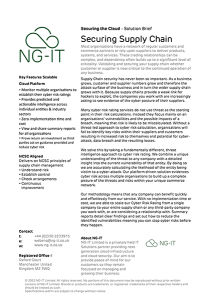Most companies now rely on third parties or trusted partner to deliver some element of their business, and information about customers and other private data is usually spread among several organisations delivering services. So securing your supply chain is more important than ever.
As larger companies have improved their information security in recent years, adversaries have looked to find easier ways of compromising their targets. Cybercriminals and state-actors are therefore increasingly looking to compromise these softer targets and exploit the relationship of trust they have with the larger entities, in what is called a supply chain compromise.
This shift is driving the need for dedicated solutions to assess and mitigate this risk, in turn securing your supply chain. Factors from the target’s side are also driving this shift, the increasingly interconnected nature of modern businesses means that there are more opportunities to exploit privileged access and hop from one network to another to achieve an ultimate goal of data theft, compromise or ransom.
Despite this increasing threat, there remain practical steps to mitigate the cyber risk associated with supply chains, organisations needing effective management of supply chain are encouraged to adopt some fundamental principles; understand risk, establish control and implement a continuous improvement commitment to information security.
Our Cyber Risk Rating solution helps companies identify the different type and level of vulnerability and threat that different companies in a supply chain have. Crucially, it also helps companies – and their suppliers – identify, understand, and mitigate these threats and vulnerabilities, and make themselves less attractive from an attacker’s perspective.
- Proactively understand both your current threats and live vulnerabilities.
- Assess cyber risks within your trading network.
- Turn large volumes of threat data into actionable insight.
- Understand the current threat activity against your sector.
- Intelligence of threat activity in countries where you operate.
- Verify security posture of your web connected infrastructure.
- Identify breached data and employee credentials.
- Evidence cyber risk to third parties with comprehensive reports.





